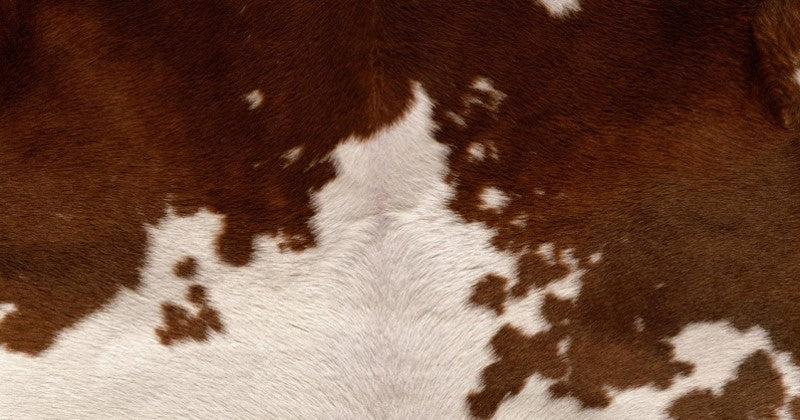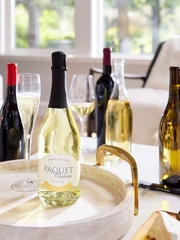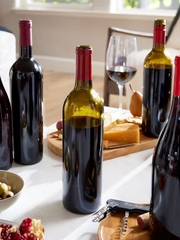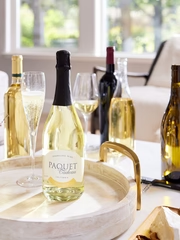Give or take two million years, Homo Erectus appeared on Planet Earth. Humans during this period of history were doing 3 things: protecting themselves, feeding and reproducing. Today, you can find food very easily on a farm, on your computer or in grocery stores like Safeway, Kroger and Wal-Mart. Most men during that time were crawling close to the ground and they were using their sense of smell much more than today. One day, man stood up to see his surroundings which allowed him to find food from a longer distance.

 Sight took over as the primary sense. A study showed that for every 100 sensations that stimulate the brain, 60 to 70% are from sight, 20 to 25% from hearing, 10 to 15% from touching, 2% from tasting and only 1% from smelling. We have more than 380 olfactory receptors in the mouth. We should all be able to taste bitter, salty, sweet, umami and sour.
Sight took over as the primary sense. A study showed that for every 100 sensations that stimulate the brain, 60 to 70% are from sight, 20 to 25% from hearing, 10 to 15% from touching, 2% from tasting and only 1% from smelling. We have more than 380 olfactory receptors in the mouth. We should all be able to taste bitter, salty, sweet, umami and sour.

 With all of these weapons, we should all be some lean, mean, well-trained, tasting machines. Too often, our vocabulary remains limited by lack of practice. We are all different as human beings and we learn to describe things differently from a very early age.
You hear that Malbec has some violet, plum and earthy notes – or that Pinot Gris usually has some peach, honey and pear characters. Are we all going to come up with those exact descriptors during a Wine Tasting? Probably not.
SENSATION is a physiological process, it is not conscious. The sense of smell provides odors.
PERCEPTION follows a sensation, the brain starts analyzing. We use our own images to interpret, and all of it becomes very unique and personal.
With all of these weapons, we should all be some lean, mean, well-trained, tasting machines. Too often, our vocabulary remains limited by lack of practice. We are all different as human beings and we learn to describe things differently from a very early age.
You hear that Malbec has some violet, plum and earthy notes – or that Pinot Gris usually has some peach, honey and pear characters. Are we all going to come up with those exact descriptors during a Wine Tasting? Probably not.
SENSATION is a physiological process, it is not conscious. The sense of smell provides odors.
PERCEPTION follows a sensation, the brain starts analyzing. We use our own images to interpret, and all of it becomes very unique and personal.


 Look at these pictures. Could this stream in the Rockies be used when we talk about minerality? Chalk, silex stone, flint, gun powder or limestone are also descriptors of mineral characters. Some oak wood notes can be described as resiny, woody, or pencil shavings. Animal aromas can be balsamic, musky or leathery. These aromas are difficult to express and quantify. This is the concept of perception.
I could tell you that Cab Franc has molecules of IBMP, or green bell pepper characters (3 isobutyl methoxypyrazine). If you have tasted a Beaujolais Nouveau, you got a nose and mouthful of CIS-3-HEXENYL-ACETATE, best known as banana or apple aromas. All of these smells are described by a visual reference.
Trying to translate your senses into words is indeed often very hard. Wine can evolve in a glass for several minutes. If you perceive some black currant in the attack of the Halcyon Cab, or some blueberry in the Homage Merlot, these flavors are going to go away fairly quickly. Aromas are caused by the sum of twenty to thirty different molecules. Very few molecules have a very distinctive smell. Terroir is expressed when all of the following is combined: rootstock, varietals, soil, climate, blending or temperature during service. These elements will influence our senses when tasting a wine.
The bouquet of wine is best revealed by gently swirling the wine in a glass to expose it to more oxygen and releasing more aromatic molecules.
Look at these pictures. Could this stream in the Rockies be used when we talk about minerality? Chalk, silex stone, flint, gun powder or limestone are also descriptors of mineral characters. Some oak wood notes can be described as resiny, woody, or pencil shavings. Animal aromas can be balsamic, musky or leathery. These aromas are difficult to express and quantify. This is the concept of perception.
I could tell you that Cab Franc has molecules of IBMP, or green bell pepper characters (3 isobutyl methoxypyrazine). If you have tasted a Beaujolais Nouveau, you got a nose and mouthful of CIS-3-HEXENYL-ACETATE, best known as banana or apple aromas. All of these smells are described by a visual reference.
Trying to translate your senses into words is indeed often very hard. Wine can evolve in a glass for several minutes. If you perceive some black currant in the attack of the Halcyon Cab, or some blueberry in the Homage Merlot, these flavors are going to go away fairly quickly. Aromas are caused by the sum of twenty to thirty different molecules. Very few molecules have a very distinctive smell. Terroir is expressed when all of the following is combined: rootstock, varietals, soil, climate, blending or temperature during service. These elements will influence our senses when tasting a wine.
The bouquet of wine is best revealed by gently swirling the wine in a glass to expose it to more oxygen and releasing more aromatic molecules.

 Wine is social because together around an open bottle, even if you are not a connoisseur, you will find something to say. Smelling and tasting adds structure to our smelly universe. This learning exercise helps us describe this world of flavors with a richer and more accurate vocabulary. The goal is to find aromatic descriptors that you will be able to retrieve from your olfactive memory when you encounter the same types of smells. One day we may describe wines using only images as shown above. So practice tasting, smelling and touching and your world will become more interesting and accessible.
Wine is social because together around an open bottle, even if you are not a connoisseur, you will find something to say. Smelling and tasting adds structure to our smelly universe. This learning exercise helps us describe this world of flavors with a richer and more accurate vocabulary. The goal is to find aromatic descriptors that you will be able to retrieve from your olfactive memory when you encounter the same types of smells. One day we may describe wines using only images as shown above. So practice tasting, smelling and touching and your world will become more interesting and accessible.


 Sight took over as the primary sense. A study showed that for every 100 sensations that stimulate the brain, 60 to 70% are from sight, 20 to 25% from hearing, 10 to 15% from touching, 2% from tasting and only 1% from smelling. We have more than 380 olfactory receptors in the mouth. We should all be able to taste bitter, salty, sweet, umami and sour.
Sight took over as the primary sense. A study showed that for every 100 sensations that stimulate the brain, 60 to 70% are from sight, 20 to 25% from hearing, 10 to 15% from touching, 2% from tasting and only 1% from smelling. We have more than 380 olfactory receptors in the mouth. We should all be able to taste bitter, salty, sweet, umami and sour.

 With all of these weapons, we should all be some lean, mean, well-trained, tasting machines. Too often, our vocabulary remains limited by lack of practice. We are all different as human beings and we learn to describe things differently from a very early age.
You hear that Malbec has some violet, plum and earthy notes – or that Pinot Gris usually has some peach, honey and pear characters. Are we all going to come up with those exact descriptors during a Wine Tasting? Probably not.
SENSATION is a physiological process, it is not conscious. The sense of smell provides odors.
PERCEPTION follows a sensation, the brain starts analyzing. We use our own images to interpret, and all of it becomes very unique and personal.
With all of these weapons, we should all be some lean, mean, well-trained, tasting machines. Too often, our vocabulary remains limited by lack of practice. We are all different as human beings and we learn to describe things differently from a very early age.
You hear that Malbec has some violet, plum and earthy notes – or that Pinot Gris usually has some peach, honey and pear characters. Are we all going to come up with those exact descriptors during a Wine Tasting? Probably not.
SENSATION is a physiological process, it is not conscious. The sense of smell provides odors.
PERCEPTION follows a sensation, the brain starts analyzing. We use our own images to interpret, and all of it becomes very unique and personal.


 Look at these pictures. Could this stream in the Rockies be used when we talk about minerality? Chalk, silex stone, flint, gun powder or limestone are also descriptors of mineral characters. Some oak wood notes can be described as resiny, woody, or pencil shavings. Animal aromas can be balsamic, musky or leathery. These aromas are difficult to express and quantify. This is the concept of perception.
I could tell you that Cab Franc has molecules of IBMP, or green bell pepper characters (3 isobutyl methoxypyrazine). If you have tasted a Beaujolais Nouveau, you got a nose and mouthful of CIS-3-HEXENYL-ACETATE, best known as banana or apple aromas. All of these smells are described by a visual reference.
Trying to translate your senses into words is indeed often very hard. Wine can evolve in a glass for several minutes. If you perceive some black currant in the attack of the Halcyon Cab, or some blueberry in the Homage Merlot, these flavors are going to go away fairly quickly. Aromas are caused by the sum of twenty to thirty different molecules. Very few molecules have a very distinctive smell. Terroir is expressed when all of the following is combined: rootstock, varietals, soil, climate, blending or temperature during service. These elements will influence our senses when tasting a wine.
The bouquet of wine is best revealed by gently swirling the wine in a glass to expose it to more oxygen and releasing more aromatic molecules.
Look at these pictures. Could this stream in the Rockies be used when we talk about minerality? Chalk, silex stone, flint, gun powder or limestone are also descriptors of mineral characters. Some oak wood notes can be described as resiny, woody, or pencil shavings. Animal aromas can be balsamic, musky or leathery. These aromas are difficult to express and quantify. This is the concept of perception.
I could tell you that Cab Franc has molecules of IBMP, or green bell pepper characters (3 isobutyl methoxypyrazine). If you have tasted a Beaujolais Nouveau, you got a nose and mouthful of CIS-3-HEXENYL-ACETATE, best known as banana or apple aromas. All of these smells are described by a visual reference.
Trying to translate your senses into words is indeed often very hard. Wine can evolve in a glass for several minutes. If you perceive some black currant in the attack of the Halcyon Cab, or some blueberry in the Homage Merlot, these flavors are going to go away fairly quickly. Aromas are caused by the sum of twenty to thirty different molecules. Very few molecules have a very distinctive smell. Terroir is expressed when all of the following is combined: rootstock, varietals, soil, climate, blending or temperature during service. These elements will influence our senses when tasting a wine.
The bouquet of wine is best revealed by gently swirling the wine in a glass to expose it to more oxygen and releasing more aromatic molecules.
- STRUCTURE: equilibrium formed by the attack, the middle and the finish. The structure is different for each style and varietal.
- BALANCE: acidity, sweetness and tannins. Some wines or certain varietals do not have all of these components.

 Wine is social because together around an open bottle, even if you are not a connoisseur, you will find something to say. Smelling and tasting adds structure to our smelly universe. This learning exercise helps us describe this world of flavors with a richer and more accurate vocabulary. The goal is to find aromatic descriptors that you will be able to retrieve from your olfactive memory when you encounter the same types of smells. One day we may describe wines using only images as shown above. So practice tasting, smelling and touching and your world will become more interesting and accessible.
Wine is social because together around an open bottle, even if you are not a connoisseur, you will find something to say. Smelling and tasting adds structure to our smelly universe. This learning exercise helps us describe this world of flavors with a richer and more accurate vocabulary. The goal is to find aromatic descriptors that you will be able to retrieve from your olfactive memory when you encounter the same types of smells. One day we may describe wines using only images as shown above. So practice tasting, smelling and touching and your world will become more interesting and accessible.






